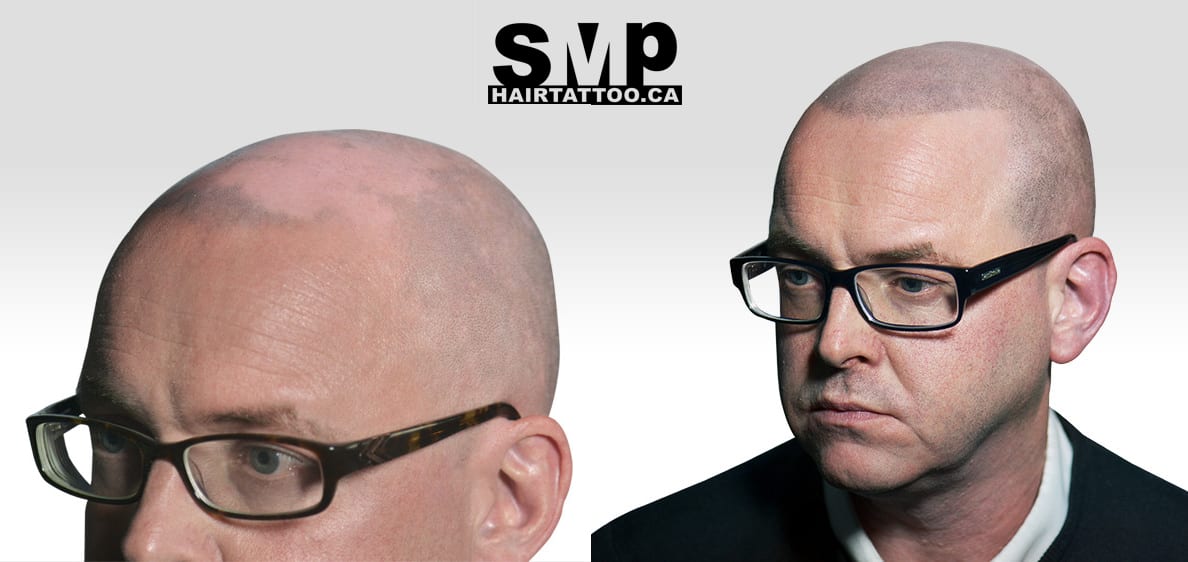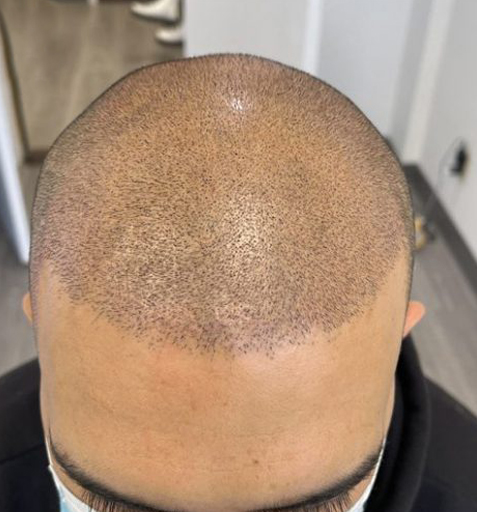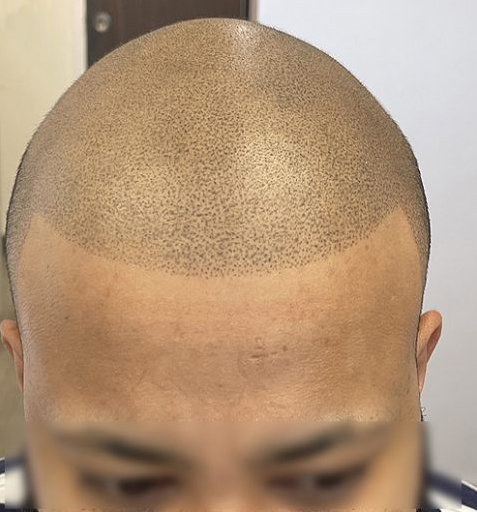
Table of Contents
Table of Contents
Hair loss is widespread. How common? According to the American Academy of Dermatology, over 80 million people in the United States are affected by hair loss, mainly male pattern baldness. One solution is SMP, but the question always arises, does scalp micropigmentation look real?
Chances are you’ve seen something online or heard from a friend that a new hair loss treatment gives guys the look of a short buzz cut. But what is scalp micropigmentation, and will it look like real hair?
It’s one of the most asked questions we hear from clients during their consultations. Is scalp micropigmentation detectable? Will anyone at work notice? We completely get it. It’s a big decision, and you want to ensure this isn’t just another Instagram ad product like that wrinkle-free t-shirt you clicked on during lunch.
First, let’s start by breaking down what scalp micropigmentation is and how it works to eliminate hair loss. Scalp micropigmentation is a drug-free, non-invasive, permanent solution to hair loss that uses tiny micro-needles to replicate hair follicles on the scalp. The results are immediate, and there is little to no maintenance. If you are thinning plus receding in some areas or have gone completely bald, we can give you the look of a full hairline. Unlike hair transplants or hair systems, scalp micropigmentation is a very subtle yet effective change.
Aside from the eye test, there are three main factors in ensuring the scalp micropigmentation treatment looks real. But before that, let’s first understand SMP in little more detail.
Scalp Micropigmentation (SMP) is a cosmetic procedure designed to help people with hair loss. It creates the appearance of a fuller scalp by using fine pigment dots that mimic hair follicles. This treatment is becoming a popular choice for individuals looking to enhance their hairline or add density to thinning areas.
Many people wonder if SMP looks natural and blends seamlessly with their existing hair. When performed correctly, SMP can look very realistic. It gives the impression of closely cropped or shaved hair, making it hard to distinguish from real hair follicles.
This article explores the factors that affect how realistic SMP looks. You will learn how elements like hair type, pigment matching, and practitioner skill impact the final result. The guide also provides tips on achieving the best outcome from your SMP treatment.
Your hair type influences how SMP looks. Thick or coarse hair blends well with the pigment. Fine or sparse hair creates more contrast, making the treatment stand out. Short hair works best for SMP. The dots look like natural hair follicles on a shaved or buzzed scalp.
The pigment colour needs to match your scalp and hair. A mismatch creates an unnatural contrast. An experienced practitioner selects a shade that blends with your skin tone. The right pigment makes the result look seamless.
A skilled practitioner plays a big role in achieving natural results. A trained artist places the dots to mimic natural hair growth. The dots blend into your hairline and scalp. Poor technique creates harsh lines or uneven patterns, which look unnatural.
Your scalp’s condition can affect the result. Textured scalps help the dots blend better. Smooth scalps may show the pigment more clearly. Healthy scalps allow the pigment to settle evenly. Damaged or unhealthy scalps may cause fading or uneven dots.
SMP creates the appearance of natural shaved hair by using tiny pigment dots to mimic hair follicles. These dots are strategically placed to match the pattern and density of natural hair growth. A skilled practitioner ensures the dots blend with your scalp and existing hairline, making it difficult to tell the difference between the pigments and real hair follicles.
Short or closely shaved hair enhances the natural look of SMP. The pigments blend seamlessly with the scalp, giving the impression of a uniform, full head of hair. This is why SMP works best for individuals who maintain a buzzed or cropped hairstyle. Longer hair can make the dots more noticeable and disrupt the illusion of shaved hair.
The treatment can appear almost undetectable when applied with precision. SMP enhances thinning areas and creates a consistent appearance across the scalp. People with receding hairlines or bald spots often find SMP particularly effective in achieving a natural, fuller look that boosts their confidence.
Certain factors make SMP look less real.
A skilled Scalp Micropigmentation Artist is essential for achieving realistic results with SMP. An experienced artist understands how to match pigments to your scalp and hair colour. They also know the right techniques to mimic natural hair growth patterns. A practitioner with proper training will create a seamless look that blends with your natural hairline.
You should research the practitioner’s experience and client reviews. Look for examples of their past work to see if their style matches your needs. Positive feedback from previous clients can give you confidence in their abilities. Selecting someone with proven expertise increases the chances of getting a natural-looking outcome.
Proper aftercare plays a crucial role in maintaining the appearance of SMP. Keeping your scalp clean helps the pigment settle evenly. Avoid scratching or touching the treated area, as this can interfere with healing. Protecting the scalp ensures the pigment stays intact during the healing process.
Sun exposure can cause the pigment to fade quickly. You should avoid direct sunlight and use a hat or sunscreen when necessary. Following the practitioner’s aftercare instructions will help preserve the treatment and keep your SMP looking fresh for years.
The pigment must match your scalp and hair colour for a natural result. A skilled practitioner will help you choose a shade that blends seamlessly with your skin tone. The right pigment colour reduces contrast and makes the dots look like natural hair follicles.
Matching the pigment to your scalp is especially important for people with unique hair colors or skin tones. Poor pigment selection can create a stark, unnatural look. Working with an experienced practitioner ensures the pigment complements your natural features.
SMP can create the illusion of a fuller scalp, but it does not restore natural hair. You should understand that the treatment mimics the look of shaved hair or closely cropped follicles. A realistic mindset helps you appreciate the results without expecting more than what SMP can provide.
Discuss your goals with your practitioner before the procedure. Explain what you want to achieve so they can guide you on what’s possible. Clear communication ensures the treatment aligns with your expectations, leading to satisfaction with the final result.
SMP can look real when applied by a skilled artist. Factors like your hair type, pigment choice, and scalp condition all play a role. Properly placed dots blend naturally into your hairline. Short hair enhances the realistic effect.
Poor application, mismatched pigments, or lack of care may make the results less convincing. Working with a skilled artist and following aftercare helps you achieve the best outcome. SMP is a great option for people who want a fuller-looking scalp and improved confidence.






© 2024 HAIRTATTOO.CA | Scalp Micropigmentation & Trichology Centre
